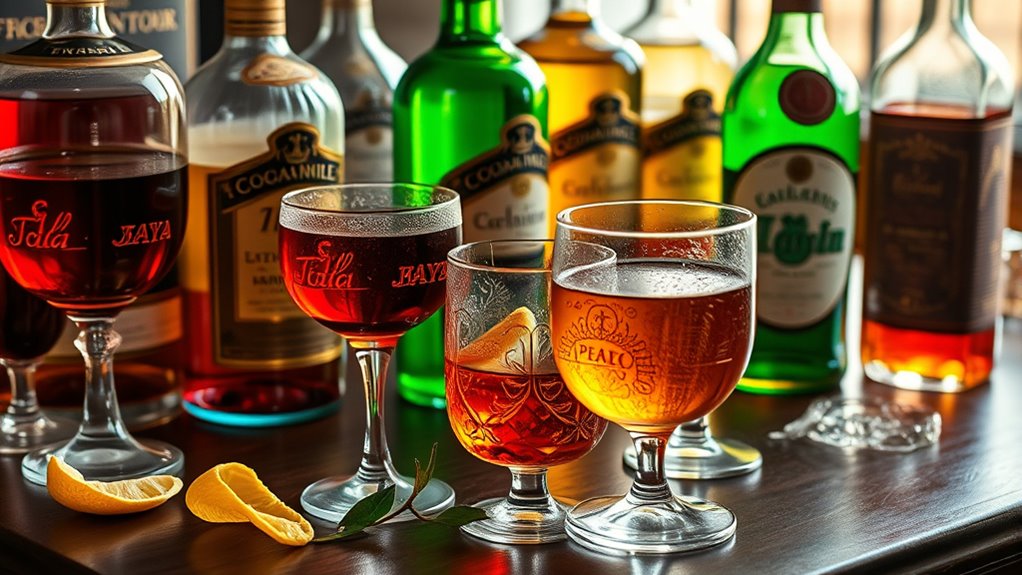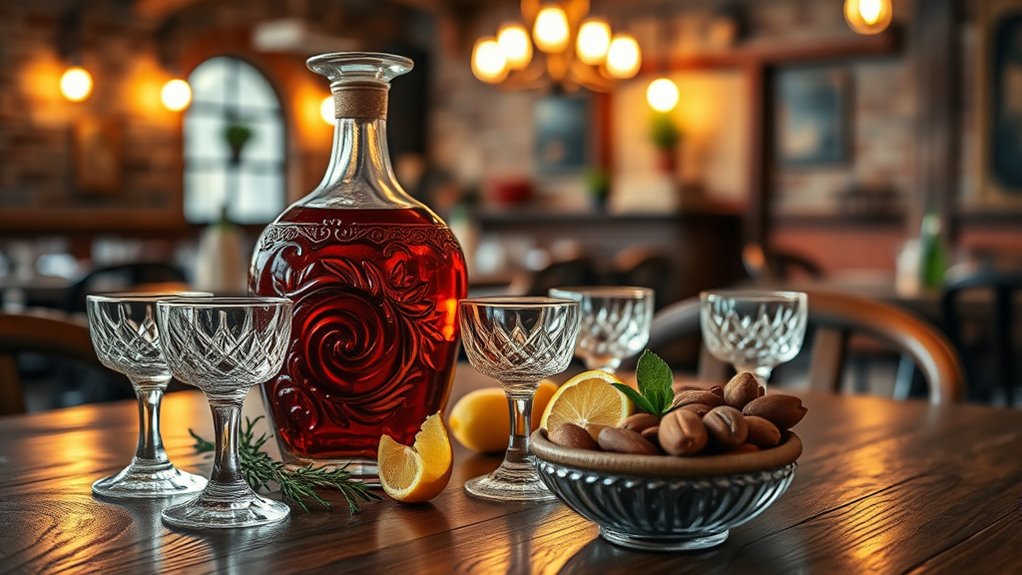Italian bitter liqueurs are rooted in centuries of tradition, originating from herbal remedies crafted by monks and apothecaries. Today, they serve as iconic aperitifs that stimulate your appetite and add flavor to social gatherings. Regional influences and artisanal methods shape their unique herbal, citrus, and spice profiles. If you continue exploring, you’ll discover how these historic spirits blend flavor, culture, and craftsmanship to create a truly authentic Italian experience.
Key Takeaways
- Italian bitter liqueurs like Aperol, Campari, and Cynar have centuries-old roots in herbal remedies and social traditions.
- Regional variations reflect local ingredients, with northern spirits emphasizing herbs and citrus, and southern ones incorporating spices and citrus peels.
- Traditionally crafted by monks and apothecaries, these spirits evolved from medicinal uses to popular aperitifs for stimulating appetite.
- Production involves maceration, distillation, and blending of herbs, roots, and citrus peels, preserving artisanal flavors.
- They hold cultural significance as versatile ingredients in cocktails and social rituals, embodying Italy’s rich culinary heritage.

Italian bitter liqueurs have a rich heritage that dates back centuries, and they continue to captivate enthusiasts worldwide with their complex flavors. Their history is deeply intertwined with Italy’s cultural and culinary traditions, evolving over time from local herbal remedies to refined aperitifs enjoyed globally. You might find that each region in Italy has its own unique take on these spirits, reflecting local ingredients, climate, and history. For example, you’ll discover that northern regions like Piedmont and Lombardy produce bitters with a focus on herbal and citrus notes, often influenced by monastic recipes passed down through generations. In contrast, southern areas such as Sicily and Calabria incorporate more aromatic herbs, citrus peels, and spices, giving their liqueurs a distinct regional character.
The history of Italian bitter liqueurs is rooted in the ancient practice of using herbs and botanicals for medicinal purposes. Monks and apothecaries originally crafted these concoctions to treat ailments, blending local herbs, roots, and spices into potent elixirs. Over time, these medicines shifted into social and cultural staples, especially as aperitifs to stimulate the appetite before meals. Today, their tradition persists, but the focus has evolved from medicinal to culinary enjoyment. You’ll notice that many of these liqueurs, such as Aperol, Campari, and Cynar, have become iconic symbols of Italy’s vibrant drinking culture, often enjoyed in social settings and celebrated in classic cocktails. Additionally, modern producers often emphasize artisanal methods to preserve traditional flavors and techniques.
Regional variations are a testament to Italy’s diverse landscape and rich botanical resources. In some areas, bitter liqueurs are infused with native herbs like myrtle, juniper, and mountain herbs, creating complex layers of flavor. Others emphasize citrus peels, such as blood orange and lemon, which add brightness and zest. The production methods also vary—some are macerated with alcohol and sugar, while others involve distillation or blending. This diversity means you get a broad spectrum of flavors, from intensely herbal and bitter to sweet and citrusy, depending on where you’re tasting them. Whether you’re sipping a glass of amaro after dinner or mixing a cocktail, understanding this regional variation enriches your appreciation of these spirits’ deep-rooted history and cultural significance.
Frequently Asked Questions
How Are Italian Bitter Liqueurs Traditionally Served?
You often serve Italian bitter liqueurs neat or over ice, emphasizing their complex flavors. Pair them with light snacks like olives or nuts to enhance the experience. Historically, these liqueurs originated as digestive aids, so serving them as an aperitif follows this tradition. You can also enjoy them as part of cocktails or with a splash of soda, making each sip a nod to Italy’s rich aperitif customs and pairing suggestions.
What Are the Key Ingredients in Classic Italian Bitter Liqueurs?
You’ll find that the key ingredients in classic Italian bitter liqueurs include a variety of botanical blends and herbal infusions. These typically consist of bitter herbs, roots, and spices like gentian, cinchona, and orange peel, which give the liqueurs their distinctive flavor. The botanicals are steeped in alcohol, creating a complex, aromatic base that’s perfect for serving as an aperitif or in cocktails, highlighting Italy’s rich tradition of herbal craftsmanship.
Can Italian Bitter Liqueurs Be Used in Cocktails?
Imagine transforming your cocktail hour with a splash of Italian bitter liqueurs—yes, you can! These complex flavors add depth and intrigue to your drinks, perfect for creative flavor pairing. Use them in cocktail recipes to craft bittersweet, aromatic concoctions that surprise and delight. Their versatility makes them a must-have for any home bartender looking to elevate their mixology game and evoke genuine appreciation from your guests.
How Should I Store Italian Bitter Liqueurs for Longevity?
To guarantee your Italian bitter liqueurs stay fresh and maintain shelf stability, store them in a cool, dark place away from direct sunlight and temperature fluctuations. Keep the bottles tightly sealed after each use to prevent oxidation. Proper storage tips help preserve their flavor and aroma over time. Avoid storing them in the refrigerator, as extreme cold can dull their complex profiles. With these tips, your liqueurs will stay delicious longer.
Are There Regional Variations of Bitter Liqueurs Across Italy?
You’ll find regional variations of bitter liqueurs across Italy, each with unique flavor profiles shaped by local botanical influences. For example, in northern regions, you might taste more citrus and herbs, while southern areas emphasize spices and native plants. These variations reflect Italy’s diverse terroirs and traditions, so exploring different regions lets you experience a wide spectrum of authentic, locally inspired bitter liqueurs that truly capture Italy’s rich botanical heritage.
Conclusion
As you sip on these Italian bitter liqueurs, you’re tasting centuries of tradition bottled up in every drop. Their complex flavors dance like a lively opera, inviting you to discover Italy’s rich cultural tapestry. Whether enjoyed as an aperitif or a calming end to your day, these elixirs are more than drinks—they’re a journey through history and passion. So, embrace the bold, embrace the bitter, and let each glass transport you to Italy’s vibrant heart.









